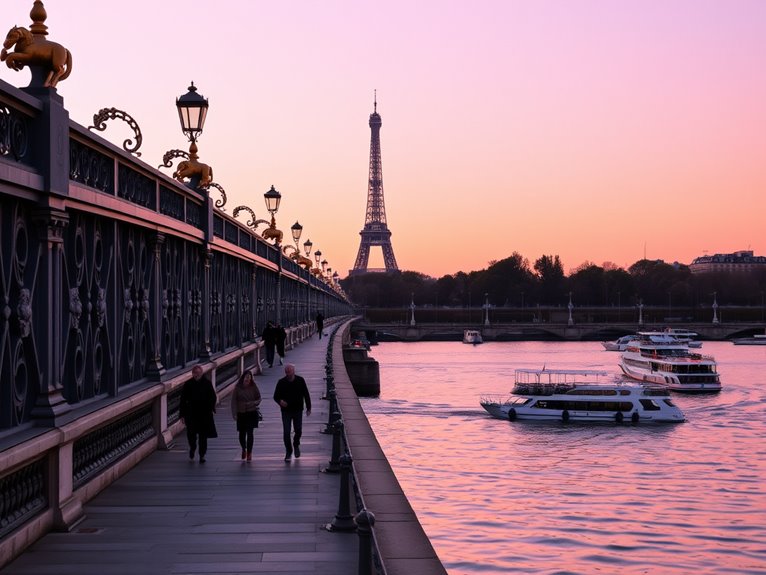
7 Historic Bridges in Paris With Romantic Views
Paris's most romantic bridges offer incredible views and rich history! I'd recommend starting with the stunning Pont Alexandre III, famous for its ornate Art Nouveau lamps and golden sculptures. You'll also love the historic Pont Neuf (Paris's oldest bridge), the wish-granting Pont Marie, and the picturesque Pont des Arts. Don't miss Pont au Double near Notre-Dame, Pont de Bir-Hakeim's Eiffel Tower views, or Passerelle Debilly at sunset. Each bridge tells its own enchanting story.
Pont Alexandre III: The Most Ornate Bridge in Paris
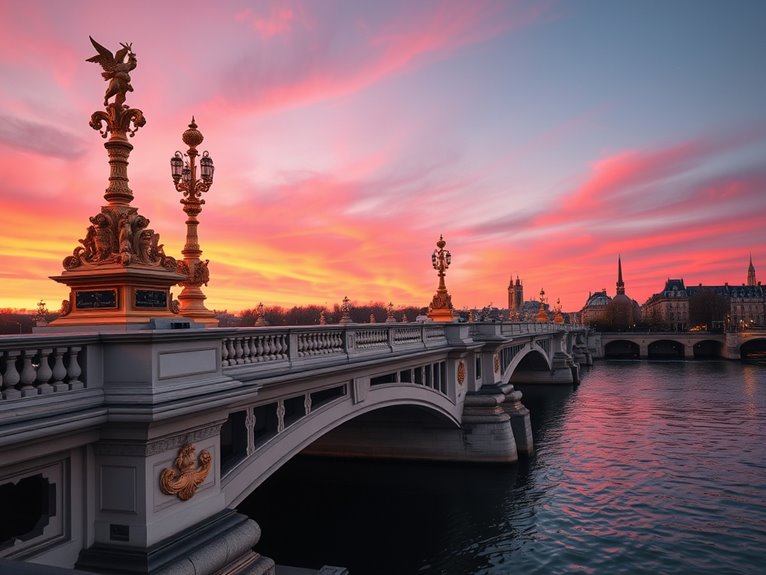
Standing as a monument to French architectural grandeur, the Pont Alexandre III is widely considered the most beautiful and ornate bridge in Paris. This stunning Belle Époque masterpiece, inaugurated for the 1900 World's Fair, spans the Seine River with an elegant single arch that connects the Champs-Élysées quarter with the Invalides area, creating one of the most photographed vistas in the City of Light.
Beyond its practical function as a river crossing, the bridge serves as an open-air museum of French art and craftsmanship. Its elaborate design features Art Nouveau lamps, exquisite sculptures of nymphs and cherubs, and four massive gilt-bronze Fames restraining Pegasus at each corner. The bridge's low profile was specifically engineered not to obstruct views of the Champs-Élysées or the Invalides, making it a masterpiece of both engineering and aesthetics.
Quick Facts:
- Best visiting hours: Dawn to 10 AM for photography
- Access: Free, 24/7
- Nearest Metro: Invalides or Champs-Élysées-Clemenceau
- Photography tips: Golden hour lighting creates magical reflections
- Bridge length: 160 meters (525 feet)
- Walking time: 5-10 minutes to cross
- Best views: From the right bank facing Les Invalides
The Bridge's Architecture
The Pont Alexandre III showcases the pinnacle of French engineering and artistic achievement from the Belle Époque period. The bridge's single steel arch spans 107.5 meters (353 feet) and was a technological marvel for its time. The four decorative pillars crowned with gilt-bronze statues rise 17 meters (56 feet), creating dramatic entry points at both ends of the bridge. Insider tip: Look for the small "N" emblems hidden in the decorative elements, a subtle reference to Napoleon.
Artistic Elements
The bridge features an astounding collection of Art Nouveau lamps, ornate sculptures, and decorative elements representing the Franco-Russian Alliance. The nymphs of the Seine and Neva rivers are depicted in relief panels, while water-themed artwork adorns the arches. Lesser-known detail: The bronze decorations were intentionally designed to complement the golden dome of Les Invalides, creating a harmonious visual connection across the Seine.
Historical Significance
Named after Tsar Alexandre III to commemorate the Franco-Russian Alliance of 1892, the bridge symbolizes both diplomatic friendship and artistic collaboration. The foundation stone was laid by Alexandre's son, Nicholas II, and the bridge remains one of the most significant symbols of Franco-Russian relations in Paris. Unique feature: The bridge's construction required innovative counterweight systems to achieve its unusually flat arch while maintaining structural integrity.
Pro Tips:
For the most memorable experience, visit during sunrise when the first light catches the gilt bronze sculptures and creates stunning reflections on the Seine. Photographers should position themselves on the right bank near the small garden area for the best shots incorporating both the bridge and Les Invalides. During summer evenings, local musicians often perform on the bridge, creating an enchanting atmosphere perfect for romantic strolls.
Practical Advice:
While the bridge is accessible year-round, be cautious during wet weather as the ornate stonework can become slippery. For the best experience, combine your visit with exploration of nearby attractions like the Grand Palais and Petit Palais. Consider visiting during Paris Fashion Week when the bridge often serves as a backdrop for fashion shoots and cultural events, though expect larger crowds during these times.
Pont Des Arts: the Famous Love Locks Bridge
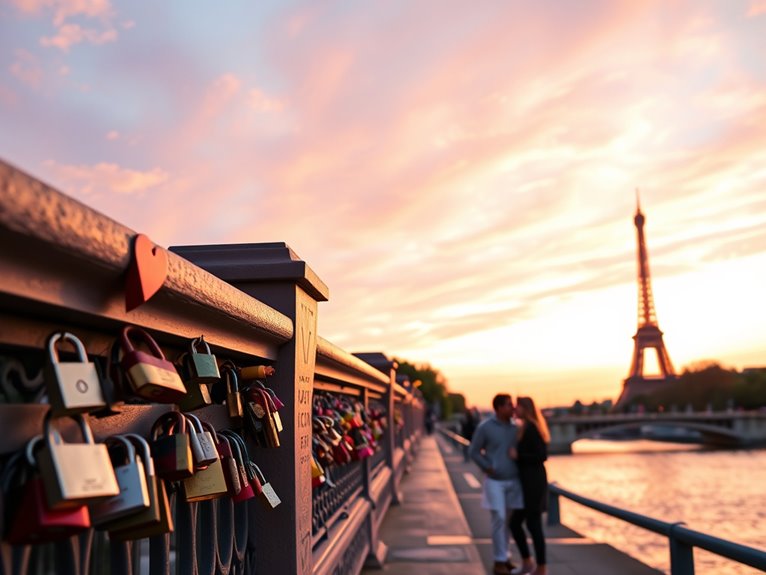
The Love Locks Bridge: Pont des Arts
——————————————
The Pont des Arts, spanning the Seine River in central Paris, has become one of the city's most iconic modern symbols of romance. Originally built between 1802 and 1804, this pedestrian bridge gained international fame in the late 2000s when couples began attaching padlocks, known as "love locks," to its railings as a symbol of their eternal love, throwing the keys into the Seine below.
Though the original love locks were removed in 2015 due to structural concerns (they weighed over 45 tons), the Pont des Arts remains a powerful attraction for visitors seeking to experience one of Paris's most romantic locations. The bridge now features art installations and glass panels, offering exceptional views of the Seine, the Louvre, and the Institut de France.
Quick Facts:
- Best visiting times: Sunrise and sunset for ideal photography
- Cost: Free admission
- Peak crowds: 11 AM – 4 PM daily
- Length: 155 meters (509 feet)
- Photography spots: Western end for Louvre views, eastern end for Notre-Dame
- Best seasons: Spring and Fall for comfortable temperatures
- Accessibility: Fully wheelchair accessible
The New Bridge Experience
The renovated Pont des Arts features transparent panels decorated with art installations that change periodically. The removal of love locks has actually enhanced the bridge's original purpose as an artistic connection between the Louvre and the Institut de France. Insider tip: Visit during the "blue hour" (just after sunset) when the bridge's subtle lighting creates a magical atmosphere perfect for photography.
Historical Significance
Constructed during Napoleon I's reign, the Pont des Arts was the first metal bridge in Paris. The current structure, rebuilt in 1984, maintains the elegant nine-arch design of the original. Lesser-known fact: The bridge's wooden planks are replaced every 5-7 years, and visitors can sometimes purchase pieces of the old decking as souvenirs from the city's public works department.
Cultural Impact
Despite the removal of love locks, couples continue to visit the bridge for its romantic symbolism. The site has appeared in numerous films and television shows, including "Sex and the City" and "Now You See Me." Hidden gem: Small brass plaques embedded in the bridge's deck mark the spots where famous artists once set up their easels to paint the Seine's views.
Pro Tips:
For the most memorable experience, visit the Pont des Arts during weekday mornings or weekday evenings after 8 PM when crowds thin out. Combine your visit with a sunset picnic – bring a blanket, some French cheese, and wine (legal to consume on the bridge). Photographers should position themselves at the bridge's midpoint facing west for the best sunset shots over the Seine.
Practical Advice:
While the love locks are gone, the bridge's romantic atmosphere remains intact. Consider bringing a sketch pad or camera to capture the views, and wear comfortable shoes as the wooden planks can be slippery when wet. The nearest Metro stations are Louvre-Rivoli (Line 1) and Saint-Germain-des-Prés (Line 4). Remember that street vendors on the bridge are usually unofficial – purchase any souvenirs from authorized shops in the surrounding areas instead.
Pont Neuf: The Oldest Standing Bridge Across the Seine
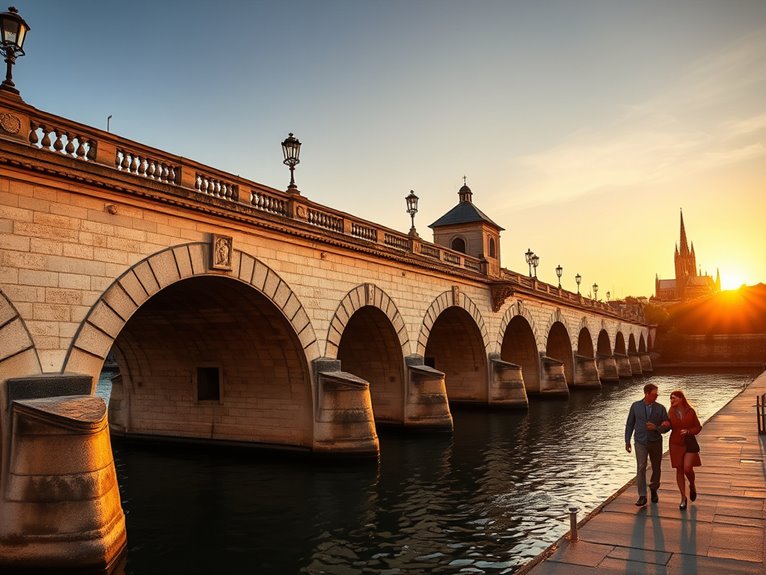
Ironically Named "New Bridge," Paris's Pont Neuf
—————————————————
Standing majestically across the Seine since 1607, the Pont Neuf holds the distinguished title of Paris's oldest existing bridge. Despite its name meaning "New Bridge" in French, this historic structure has witnessed over four centuries of Parisian history, serving as a silent observer to the city's transformations from medieval times through the French Revolution and into the modern era.
This architectural masterpiece represents a significant moment in Parisian bridge design, being the first stone bridge built without houses along its length and the first to feature sidewalks. Its distinctive design, with twelve arches spanning the Seine and decorated stone masks known as "mascarons," has made it not just an essential crossing point but a beloved symbol of Paris's architectural heritage.
Quick Facts:
- Best visiting times: Dawn and dusk for photography
- Access: Free, 24/7
- Location: 1st and 6th arrondissements
- Length: 232 meters (761 feet)
- Photography spots: Square du Vert-Galant, Pont des Arts
- Best seasons: Spring and Fall for ideal lighting
- Notable features: 384 mascarons (decorative stone masks)
The Bridge's Design and Structure
The Pont Neuf's revolutionary design features semi-circular arches instead of the traditional Gothic pointed arches, setting a new standard for bridge architecture in Paris. The bridge connects the Right Bank to the Left Bank, crossing the Île de la Cité in the middle. The mascarons, depicting satyrs and forest gods, were restored in the 1980s and remain one of the bridge's most photographed features.
Historical Significance
During the 17th century, the Pont Neuf became Paris's first public space free from commercial activity, making it a popular gathering spot for street performers, merchants, and citizens of all social classes. The bridge's construction was initiated by King Henry III and completed under Henry IV, whose equestrian statue stands proudly at the center of the bridge today.
Modern Role and Attractions
The bridge continues to serve as a integral crossing point and tourist attraction. The Square du Vert-Galant, a peaceful park beneath the bridge on the western tip of the Île de la Cité, offers unique views of the structure and serves as a popular picnic spot. The bridge's robust construction has allowed it to survive numerous floods and modifications while maintaining its original character.
Pro Tips:
For the most memorable experience, visit the Pont Neuf during the golden hour, just before sunset, when the stone takes on a warm, golden hue perfect for photography. Consider combining your visit with a Seine river cruise that passes underneath the bridge, offering a unique perspective of its impressive arches. Early morning visits (before 8 AM) provide the best opportunity for photographs without crowds.
Practical Advice:
Access the bridge from either bank of the Seine, with the nearest Metro stations being Pont Neuf (Line 7) or Cité (Line 4). While the bridge is always open, the best experience comes from visiting during clear weather conditions. For those interested in photography, bring a wide-angle lens to capture the bridge's full span, and consider visiting during weekday mornings when tourist traffic is lighter. The surrounding area offers numerous cafés and restaurants, making it easy to combine your visit with other nearby attractions like the Louvre or Sainte-Chapelle.
Pont Marie: The Bridge of Lovers' Wishes
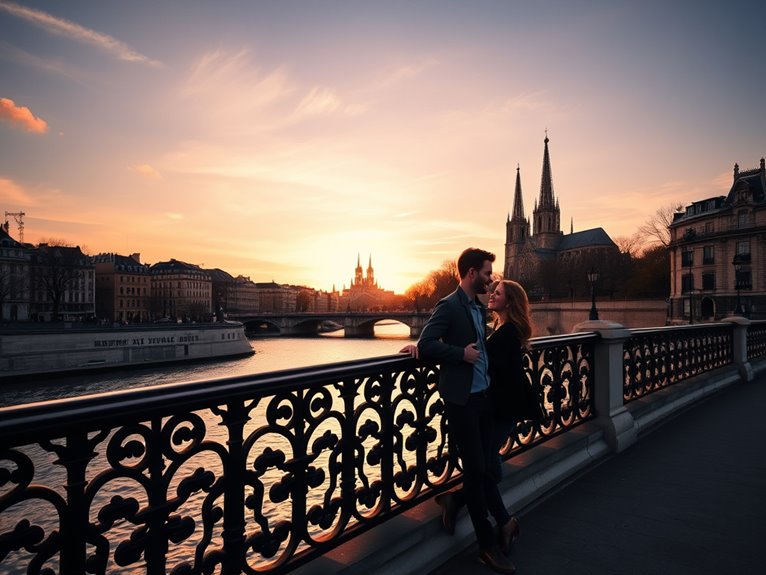
The Pont Marie: Bridge of Lovers' Wishes
——————-
Standing gracefully over the Seine River since 1635, the Pont Marie connects the Île Saint-Louis to the Right Bank of Paris, carrying with it centuries of romantic folklore and architectural significance. This historic stone bridge, often overlooked by tourists in favor of its more famous siblings like Pont Neuf, holds a special place in Parisian culture as the "Bridge of Lovers' Wishes," where couples come to make their desires known to the universe.
The bridge earned its romantic reputation through a cherished local tradition: lovers must kiss beneath its arches while making a wish, then speak their wish aloud as they cross the bridge's length. According to legend, if they complete this ritual without looking at the water below, their romantic wishes will come true within a year. This blend of architecture and romance makes the Pont Marie a unique destination for both history enthusiasts and hopeless romantics.
Quick Facts:
- Best visiting times: Sunset to early evening for romantic atmosphere
- Cost: Free access
- Photography: Golden hour (1 hour before sunset) offers ideal lighting
- Length: 92 meters
- Number of arches: 5
- Location: 4th arrondissement
- Transit: Metro stations: Pont Marie (Line 7), Saint-Paul (Line 1)
Historical Significance
The Pont Marie's construction began in 1614 under Louis XIII's reign, supervised by engineer Christophe Marie, whose name it bears. Originally featuring houses along its length, like many Parisian bridges of its era, these structures were removed in 1788 for safety reasons. The bridge remains one of Paris's oldest, surviving floods, revolutions, and modernization while maintaining its original character.
The Love Tradition
The wish-making tradition allegedly began in the 18th century when a young couple's love survived despite family opposition after they made their wishes on the bridge. Modern couples continue this ritual, often attaching small locks to the bridge's railings (though this practice is discouraged by city authorities). Insider tip: Local lovers know that wishes made at exactly 11:11 PM are said to have special power.
Pro Tips:
For the most magical experience, visit during "blue hour" – the period just after sunset when the sky takes on deep blue hues and the bridge's lights begin to twinkle. This timing not only provides the most romantic atmosphere but also offers the best photo opportunities with minimal tourist traffic. Consider bringing a small battery-operated candle to enhance the mood while making wishes (open flames are not permitted on the bridge).
Practical Advice:
While the Pont Marie welcomes visitors 24/7, evening visits should be approached with normal city safety precautions. The nearby Île Saint-Louis offers numerous cafés and ice cream shops perfect for extending your romantic outing. To fully appreciate the bridge's architecture and atmosphere, approach it from the Right Bank side, where you'll find the best views of its classical arches framing the island beyond.
Pont Au Double: Notre-Dame's Hidden Gem
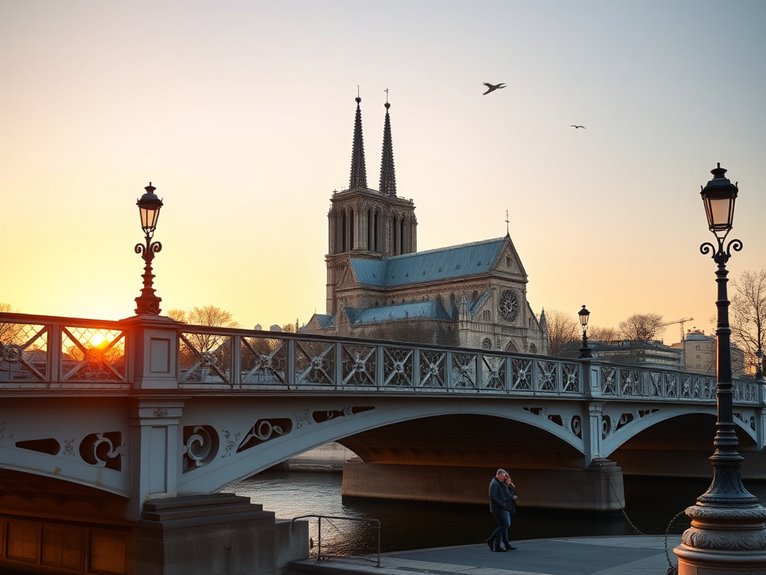
Nestled in the shadow of Notre-Dame Cathedral, the Pont au Double stands as one of Paris's most historically significant yet often overlooked bridges. This pedestrian crossing, dating back to the 13th century, earned its name from the "double denier" toll once required to cross it – a fee that helped fund the nearby Hôtel-Dieu hospital, Paris's oldest healthcare institution.
While tourists flock to the more famous Pont Neuf or Pont des Arts, the Pont au Double offers an intimate glimpse into medieval Paris's everyday life. The current iron bridge, rebuilt in 1883, connects the Left Bank's Latin Quarter with the Île de la Cité, providing spectacular views of Notre-Dame's flying buttresses and the Seine's peaceful waters that few visitors discover.
Quick Facts:
- Best visiting hours: Dawn to dusk (best light for photography)
- Length: 45 meters
- Width: 20 meters
- Photography spots: Eastern side for Notre-Dame views
- Accessibility: Fully pedestrian-friendly
- Nearest Metro: Saint-Michel Notre-Dame (RER B and C)
- Best season: Spring and autumn for ideal lighting
- Crowd levels: Generally quiet, busier during Notre-Dame visiting hours
Historical Significance:
The original wooden bridge was constructed in 1626 to facilitate access between the Hôtel-Dieu hospital and its annexes on the Left Bank. After several reconstructions, the current iron structure was designed by Jules Lax and Henri-Parent, incorporating elegant cast-iron railings and distinctive lampposts that maintain their 19th-century charm. Insider tip: Look for the small bronze plaques near the bridge's endpoints that detail its medieval toll system.
Architectural Features:
The bridge's simple yet elegant design features three arches spanning the Seine, with decorative iron railings that complement Notre-Dame's Gothic architecture. The walkway offers unique perspectives of the cathedral's architectural details often missed from other vantage points. Hidden detail: The bridge's original stone abutments remain visible during low tide, revealing medieval construction techniques.
Photographic Opportunities:
The Pont au Double provides unparalleled views of Notre-Dame's southern facade and serves as an excellent spot for sunrise photography. The bridge's elevation and orientation create perfect framing opportunities for both architectural and landscape shots. Secret spot: The northwestern corner offers a unique angle capturing both the bridge and cathedral in morning light.
Pro Tips:
Visit during early morning hours (before 8:00 AM) to capture the best light and avoid tourist crowds. The bridge's unique position makes it ideal for photographing Notre-Dame's architectural details, particularly during golden hour. Consider timing your visit with low tide to observe the original medieval stonework beneath the current structure. Local photographers often use the bridge's iron railings as natural frames for their cathedral shots.
Practical Advice:
While the bridge itself requires no entrance fee or special permissions, be mindful of ongoing Notre-Dame restoration work that may affect views and access points. Carry a wide-angle lens for architecture shots and a telephoto lens for detailed cathedral photographs. The bridge can be slippery during wet weather, so wear appropriate footwear. Consider combining your visit with exploration of the Latin Quarter's historic streets or the flower market on Île de la Cité for an all-encompassing historical experience.
Pont De Bir-Hakeim: Art Nouveau Beauty With Eiffel Tower Views
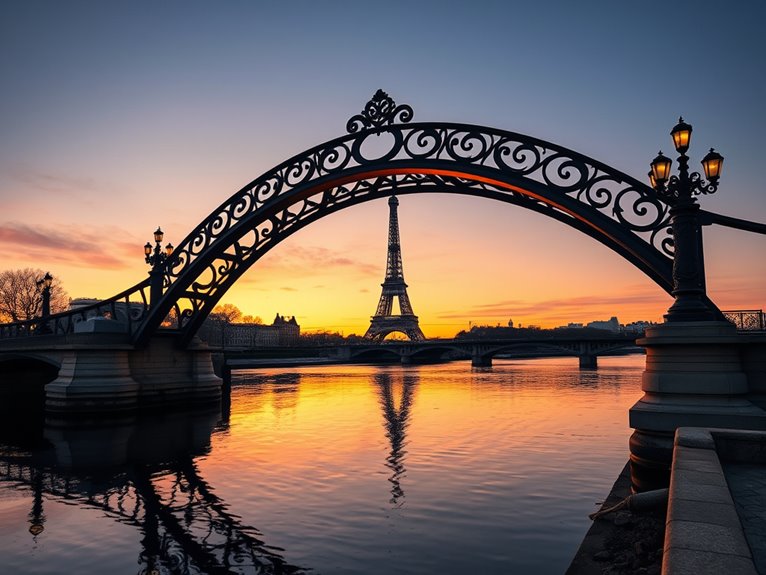
Stretching across the Seine River between the 15th and 16th arrondissements, this remarkable structure showcases the ideal marriage of form and function. Its distinctive steel colonnade, adorned with classical sculptures and geometric patterns, supports both the upper-level Metro viaduct and the lower deck for vehicles, pedestrians, and cyclists, creating an immersive architectural experience that captures the essence of Belle Époque Paris.
Quick Facts:
- Best visiting times: Dawn and dusk for ideal photography
- Access: Free 24/7
- Metro: Line 6 (crosses the bridge)
- Photography spots: Lower deck walkway and nearby Quai de Grenelle
- Peak tourist hours: 10 AM – 4 PM
- Best season: Spring and fall for clearest views
- Lighting conditions: Evening illumination starts at sunset
The Bridge Experience:
The lower deck provides an unparalleled pedestrian experience, with wide walkways flanked by decorative lamp posts and Art Nouveau railings. The vaulted metal colonnade creates fascinating light patterns throughout the day, while the central portion opens to breathtaking views of the Seine and the Eiffel Tower. Four allegorical statues by Gustave Michel grace the bridge's pillars, representing Science, Labor, Electricity, and Commerce.
Location and Access:
Situated between Quai de Grenelle and Quai Louis Blériot, the bridge is easily accessible from either bank. The nearest Metro stations are Bir-Hakeim and Passy on Line 6. The structure spans 237 meters (777 feet) and stands as one of the few remaining examples of early 20th-century architectural innovation in Paris.
Pro Tips:
Visit during the first hour after sunrise to capture the bridge without crowds and with ideal lighting conditions. Position yourself on the downstream side of the bridge for the best Eiffel Tower photographs, especially during sunset when the golden hour creates a magical atmosphere. For unique shots, consider visiting during rain showers when the wet pavement reflects the bridge's architectural details.
Practical Advice:
While the bridge is accessible year-round, be mindful of weather conditions as the walkways can become slippery when wet. The Metro crossing above creates intermittent noise, so time sensitive photography or video recording accordingly. For the best experience, combine your visit with a walk along the nearby Promenade d'Australie or schedule it before or after a Seine river cruise, which departs from nearby ports.
Passerelle Debilly: The Sunset Lover's Bridge
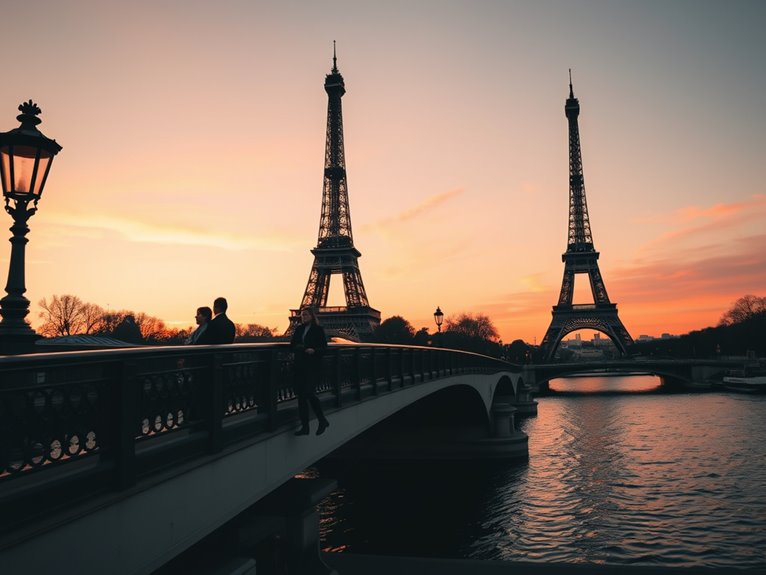
Nestled between the iconic Eiffel Tower and the Trocadéro, the Passerelle Debilly stands as a tribute to both architectural ingenuity and romantic Parisian charm. This pedestrian footbridge, originally constructed for the 1900 World's Fair, offers one of the most breathtaking views of the Seine River and has become a cherished spot for photographers, lovers, and sunset enthusiasts alike.
Originally named the Passerelle de Magdebourg, this elegant structure earned its current name in honor of General Jean Louis Debilly, who fell during the Battle of Jena in 1806. The bridge's art nouveau design, characterized by its distinctive steel framework and wooden planking, creates an intimate atmosphere that perfectly complements the surrounding Parisian landscape.
Quick Facts:
- Best visiting hours: Sunrise to sunset (especially golden hour)
- Access: Free
- Length: 120 meters
- Photography prime time: 30 minutes before sunset
- Closest Metro: Iéna (Line 9) or Passy (Line 6)
- Peak tourist seasons: June-August, December
- Best photo angles: Southeast corner facing Eiffel Tower
The Bridge Experience
The Passerelle Debilly offers an unparalleled vantage point for viewing the Eiffel Tower, particularly during sunset when the golden light bathes the iron structure in warm hues. The bridge's wooden planking and art nouveau railings create perfect framing opportunities for photographs, while the gentle sway of river traffic below adds to the dynamic atmosphere. Insider tip: The lesser-known northeast corner of the bridge provides an excellent spot for capturing both the tower and the river traffic in one shot.
Location and Access
Situated in the 16th arrondissement, the bridge connects the Quai Branly and the Quai de New York. While it serves as a practical crossing point, its relatively quiet nature compared to other Seine bridges makes it ideal for leisurely strolls and photography sessions. The bridge is accessible 24/7, though it's most magical during daylight hours. Insider tip: Visit during weekday mornings to have the bridge almost entirely to yourself.
Pro Tips:
The best time for photography is during the "blue hour" – the period just after sunset when the sky takes on deep blue tones and the Eiffel Tower's lights begin to sparkle. Professional photographers often arrive 45 minutes before sunset to secure the best positions and capture the full change from golden hour to nighttime illumination. For the most atmospheric experience, visit during spring or fall when tourist crowds are thinner and the weather is mild.
Practical Advice:
While the bridge is generally safe, keep valuables secure and be aware of your surroundings, particularly after dark. Bring a light jacket as the river breeze can be chilly, even in summer. Consider combining your visit with a stop at the nearby Musée du Quai Branly or the Trocadéro Gardens for a full afternoon of Parisian exploration. If visiting for photography, a tripod is permitted but be mindful of other pedestrians using the crossing.
